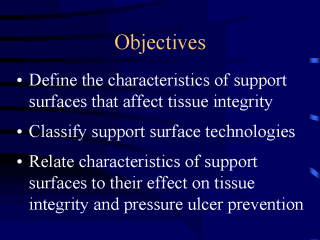 |
Prolonged
external pressure over bony prominences has long been identified as the primary
etiological factor in pressure ulcer development. Other related causative factors include
the magnitude of shear and friction forces and the additive effects of temperature and
moisture. Each of these factors can be affected by and are related to the characteristics
of the support surface. However, it is clear that while extrinsic factors such as
temperature, moisture and mechanical characteristics are critical to the development of
pressure ulcers, factors intrinsic to the patient's skin and its supporting structures,
vasculature or lymphatics also play a significant role in a patient's susceptibility to
these factors. In this presentation I concentrate on relationships between support surface
characteristics and their effects on pressure ulcer prevention. The characteristics
discussed are pressure distribution, shear, temperature control, and moisture control.
These characteristics are related to classifications of support surfaces: elastic,
viscoelastic, fluid-filled, low air loss, air-fluidized, and alternating pressure. |
